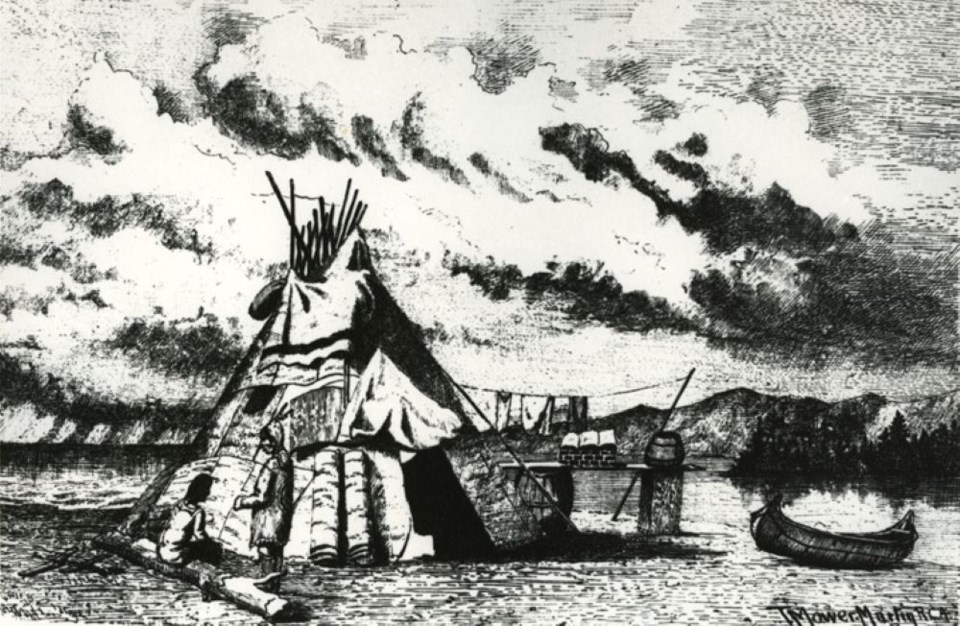“I’ll take a pair of ships knees and a jar of jam please!”
If you have enjoyed the pleasure of a lazy paddle down the St. Marys River, you will find yourself between Squirrel Island and its much larger cousin, Sugar Island, just as the foot of Lake George comes in to view. The island’s original name, Sisibakwatominiss, translates to Maple Sugar Island from the Anishinaabemowin language of the Ojibway people.
On the right-hand side of the river, you may have noticed a large, white, two-storey house tucked in amongst the majestic White Pines on the American riverbank. This building, which is currently listed on the US National Register of Historic Places, constructed in 1862 as the Church family home, is the last remaining structure of what was once known as Churchville Landing.
Philetus Swift Church, originally of New York State, migrated northwards in 1845 in search of copper in the Chippewa County area but, reverted to his skill as a merchant when he settled with his wife and two sons on Sugar Island. Church’s son, Jesse Wells Church built the family’s clapboard home. It was an impressive structure for the time period and retains a stately presence to this day.
According to the writings of Joseph and Estelle Bayliss in their 1955 publication, River of Destiny: The Saint Marys, Church began trading with the Island’s residents which were comprised of about 400 Ojibway people and the sailors aboard the steamships which sailed by frequently.
It was not long before Church started a sawmill and a shingle mill that offered milled lumber, wooden shingles, timbers pilings and ships knees. Ships knees are a curved brace that is used to reinforce the wooden walls of a ship and constructed using either a naturally occurring curved limb or cut of wood. Church also supplied wood as fuel for the boilers of the steam-powered ships that travelled through the Great Lakes.
As well as operating his own tug, and a dry dock for repairs, Church also constructed two docks whose timber pilings were still visible with the naked eye and were observed by this researcher as recently as the late 1980s.
Church was credited with creating early navigational markers for ships navigating the shallow sand bar found at the foot of Lake George. In addition to the lamp he kept lit and suspended from a post in the river to indicate his store’s location, he also had stakes set out every spring to aid the ships from running aground. In time, the task of installing and pulling these markers from the river with the change of the seasons was assumed by the government.
Some of the most famous items offered for sale at the Churchville Landing store were raspberry jam and maple syrup.
Records kept by Jesse Wells Church show that “his father’s business ranged from $17,000 to $27,000 a year. This included 3,000 cords of steamboat wood sold at $1.50 a cord, 2,000 to 4,000 Tamarack ships knees, 3,000 to 5,000 pine logs, five to 10 tons of wild raspberry jam … thousands of pounds of maple sugar … thousands of bags of charcoal sold to mine owners at Echo Bay … as well as ice, milk, soap, meat and furs … and fish by the barrel.” (Sault Star, Oct 13, 1962) Church offered a seemingly endless supply of goods and as the saying goes, his store was a veritable ‘soup to nuts’ supplier to inhabitants along this inland seaway.
Supplying this wide range of goods required the assistance of a skilled labour force and Mr. Church was known to have employed Sugar Islanders as well as anywhere from 10 to 35 residents of Ketegaunseebee (Garden River) annually. Garden River, ‘The Creator’s Garden’ was well known for its produce and traded these highly desired goods with Church as well.
Churchville Landing continued to prosper and remained a hub of shipping and commerce until Philetus Church’s wife, Elizabeth died in 1876. Mr. Church passed away at the age of 71 in 1883, a short seven years after retiring from the merchant business.
Bernard Arbic notes in The Sugar Island Sampler that Church is ‘buried in the Maple Ridge Cemetery on the top of Ashmun Hill in Sault Ste. Marie, Mich. Their son, Jesse Wells Church went on to become a doctor in Traverse City, Mich.
Eventually though, he moved his own family to Harbor Island, which is located close to Drummond Island. There he engaged in shipbuilding until about 1910. While the family home may be all that remains, the Church’s certainly impacted the economic and shipping history of Sugar Island and the St. Marys River.
Bundle up and venture down to the Sault Ste. Marie Public Library and explore the rich history of this area found between the covers of the books in our Local History collection.
Each week, the Sault Ste. Marie Public Library and its Archives provides SooToday readers with a glimpse of the city’s past.
Find out more of what the Public Library has to offer at www.ssmpl.ca and look for more Remember This? columns here.
